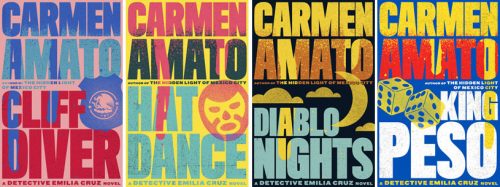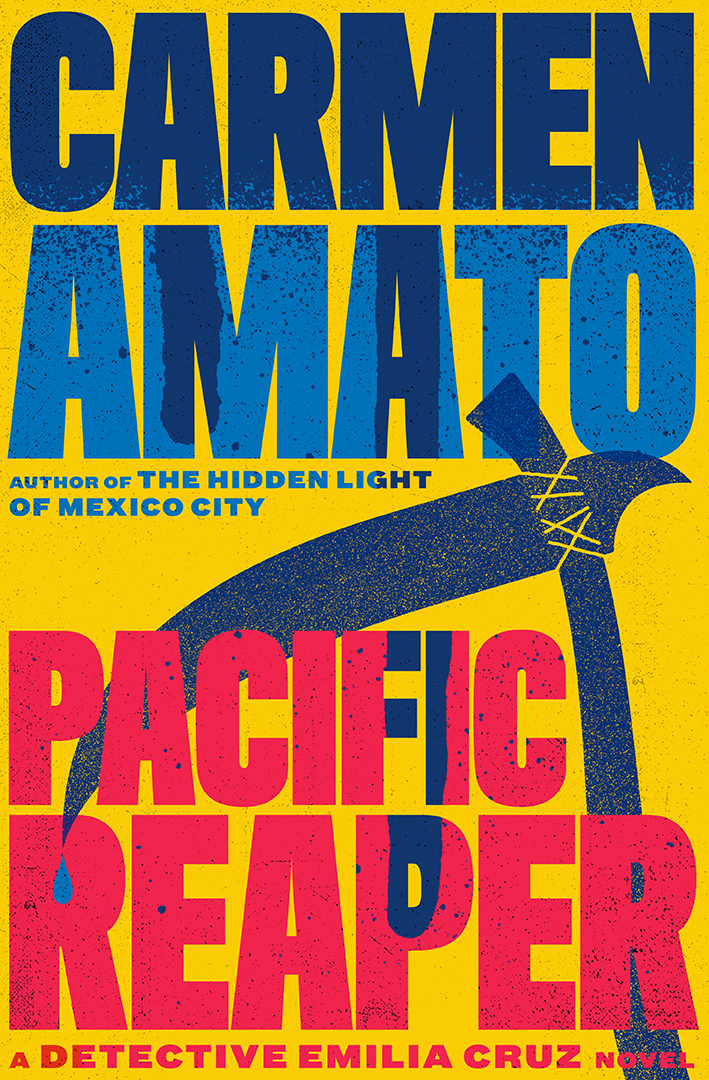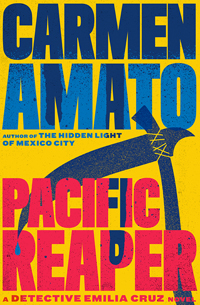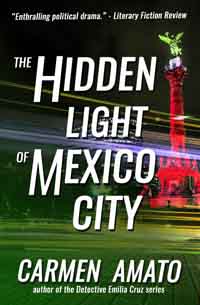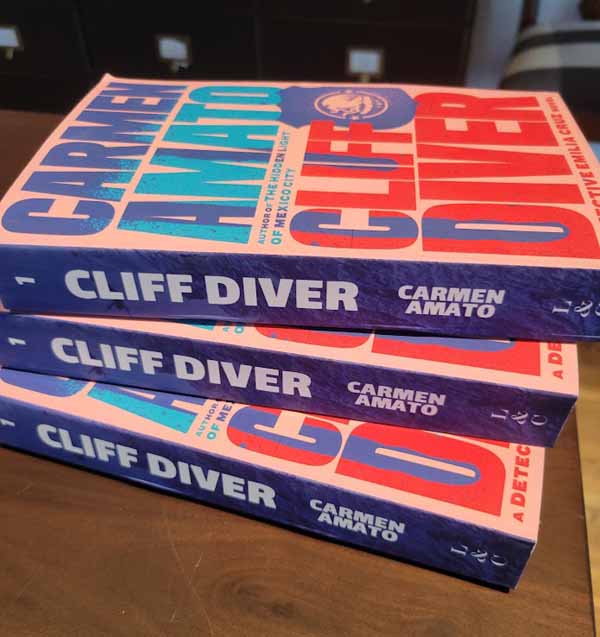
Aug 7, 2023 | #EmiliaCruz
She Said, He Said
A CLIFF DIVER scene from Franco Silvio’s Point of View

The Detective Emilia Cruz series is written from Emilia’s point of view as the first female police detective in Acapulco. She’s got some tricky geography to navigate in that position. Not only has Acapulco become Mexico’s deadliest city for those tracking homicide statistics, due to rival cartels fighting over routes north into the US and port facilities for incoming shipments of fentanyl ingredients for China, but the lucrative drug trade has spawned official corruption and human trafficking.
Basically, Emilia lives in a pressure cooker.
But what about those who inhabit Emilia’s world with her? What about their pressures, triumphs and despairs?
Let’s go inside the head of Franco Silvio and the first major confrontation between him and Emilia. It sets the tone for their future relationship as crime fiction’s odd couple.
Enjoy!
_______________
Silvio’s thoughts punched and jabbed at random theories as he drove back to the police station. He was a boxer in the ring with a ghost. Whoever bludgeoned Lieutenant Inocente to death, then sent the body out to sea in the man’s own speedboat, was a more elusive opponent than anyone Silvio fought during his championship years.
This late in the day, traffic on la Costera was a mess. Tour buses and hotel vans lumbered in the fast lane, spewing fumes and garish advertisements to See Acapulco by Night or rent fleabag shacks along the coast at Punta el Pesquero. Silvio swore as he rode the brake, unable to get around them.
Next to him, Fuentes sat slumped against the passenger door and kept his mouth shut, the smartest thing he’d done all day. Silvio’s young partner hadn’t exactly covered himself with glory in the abandoned water bottling plant.
Silvio glanced in the rearview mirror. In the back seat, both Cruz and Portillo were mindlessly staring outside. As if she was telepathic, Cruz glanced up and saw him watching her.
The sluggish traffic immediately had Silvio’s full attention again.
Cruz made him uneasy. Too smart. Too curious.
Too pretty. When Portillo took her on as partner, the rest of the detectives assumed he was doing her. Portillo once said that sex with Cruz would be like wrestling a bag of cats and he’d prefer not to bleed to death, but the rumors persisted, gleefully linking her with any man who wasn’t dead or on fire.
By the time they got back to the police station, the sun was a ball of fire sinking behind the stucco walls of the building. Twilight spread a purple haze over the parking lot. Silvio lifted his hand to the guard at the entry gate, drove through when the barrier lifted and swerved into his assigned spot.
Portillo and Fuentes bailed out.
A moment later, Silvio was crowding Cruz in the back seat. Before she could scramble away, he pressed the button on his key fob. The sedan doors locked with a beep.
“We need to talk,” he growled. “Why did you go to my house?”
Cruz tensed but she didn’t pull any panicky girl shit. “Who says I went to your house?”
“My wife is pretty accurate in her descriptions.” As soon as Isabel told him about the lovely young woman in skinny jeans and a denim jacket asking questions, Silvio knew it was Cruz.
Sneaking around his own neighborhood of El Roble. Looking for a weakness, something to exploit. He would have done the same.
“You called Lt. Inocente the night of his death.” Cruz gave him a hard look. “From your cell phone. Twice.”
“You think I killed him?” Silvio asked with a snort.
“You were his last known contact. Takes your call, walks out and never comes back. Dead the next morning. You don’t mention it to anybody, just let us run around trying to figure it out, knowing that we’d see the phone records sooner or later.”
“Did you tell Obregon?” It wasn’t the question Silvio intended to ask, but her answer would make all the difference.
He and Obregon had been sworn enemies for a long, long time. Was the union boss using Cruz as a proxy to take him down?
“Tell me what happened,” Cruz said, her tone hinting that she was ready to trade information.
Silvio decided to play. “I called Inocente,” he said. “Went to his place and we talked. He owned me money. He said he’d pay up in a day or so. I saw him go back into the building. He unlocked the door and went in. I went home.”
“He owed you? For what?”
“Nothing to do with you, Morelos da Gama or this water business.”
Cruz narrowed her eyes at him. “Was it a money scam? Trading drugs for counterfeit?”
“What?”
“I think you two were running a money scam. Involving counterfeit dollars.” Cruz shoved a handful of bills in his face.
Silvio stared at the money in surprise. “Where’d you get that?”
“The ransom for the Morelos da Gama kidnapping was paid in counterfeit dollars,” Cruz said. “Just like these.”
“What?” Counterfeit was a punch from outside the ring that he never saw coming.
“Is that what you were talking to el teniente about?” Cruz pressed, her voice loud and harsh inside the sedan.
“You’re accusing me of killing Inocente over some money laundering scheme?” Silvio leaned closer to her and fury pulled his lips into a snarl. “Go ahead, Cruz. Try to pin a murder on me and I’ll put you in the ground.”
A piercing siren filled the air. Silvio jolted back as he realized that Cruz had pressed the panic button on her own key fob. Two spaces away, her big white Suburban honked and flashed like a carnival ride.
The gate guard galloped up to the big SUV. Inside the sedan, Cruz banged on the window to get his attention.
Silvio hit the unlock button on his fob.
The guard wrenched open the rear passenger side door. Cruz flung herself out before silencing the Suburban. Silvio got out, too. The normal sounds of traffic beyond the razor wire-topped perimeter wall replaced the clanging in his ears.
He spoke to the guard over the roof of the sedan. “Sorry. Technical problem.”
Cruz backed against the side of the Suburban as the guard hustled back to his shack. One hand was on the driver’s door handle and she was breathing hard. “Answer my question. Why did Lieutenant Inocente owe you money?”
“I run a book,” Silvio said. It was a poorly kept secret; cops throughout the department placed bets with him. “Did it when I was suspended and just kept going. Inocente put down a bet, lost, and paid up with counterfeit norteamericano dollars. Fake, same as those.”
“When?”
“The week before. Tried to trace it with a couple of my informants but nobody knew anything. I didn’t know what to do and finally decided we had to have it out. I needed the money.” He was torn between telling Cruz to mind her own fucking business and making her understand why he needed Inocente to pay his debts.
“You needed it for Monday,” Cruz said slowly. “If you don’t get the accounts settled on Monday the kids don’t eat on Tuesday.”
So she knew his weak spot after all.
“My wife is a good woman,” Silvio said. He jabbed a finger at Cruz as she stood there by the Suburban, her face revealing nothing. “This means a lot to her. Things haven’t always been easy. She . . . she lost a lot of babies over the years. So these kids on the street . . . they’re like hers.”
“I want to believe you but you should have said something. You were the last person to see el teniente alive.”
Silvio wanted to shake the woman until that ponytail slapped her face. “I didn’t kill Inocente. You can call Obregon if you want and he’ll ruin my career but he won’t find any evidence that I killed him. I knew you wouldn’t believe me about the phone call so I just kept my mouth shut figuring we’d find the killer before the records came. Rayos, when was the last time we got phone records that fast?”
“Your story better check out,” Cruz warned.
“I just wanted what he owed me,” Silvio said. He was about to walk away when one of those phantom jabs rattled his brain. “Before you start chasing your tail, what did you say about a ransom?”
“Do you remember the day Rico and I got a reward for saving the kidnapped kid? Morelos da Gama’s kid?”
Silvio nodded.
“Counterfeit. Same as what I showed you.” Cruz fished out another fake bill.
A world of bad possibilities opened in front of Silvio. “Inocente gave it to you.”
“This hulk was full of it and somebody knew,” Cruz cocked her head toward the Suburban. “You remember that el teniente told me to take Kurt Rucker back to his hotel after he made his statement? Well, the army checkpoint was gone and we were ambushed by a truck full of shooters. We never made it to the hotel but I got us to my uncle’s garage. We took the car apart and found the money. A bank told us it was fake. So we left the vehicle on the side of the road and the next day the money was gone and the child was there.”
“Morelos da Gama paid his kid’s ransom with counterfeit? That’s this water company crap’s all about?”
“I don’t know exactly what happened,” she admitted. “The Pinkerton agent who worked for the family turned the ransom over to somebody who claimed to be Lt. Inocente. An accomplice, I guess. He was supposed to do the actual handoff to pay the kidnappers. The Pinkerton agent turned over pesos. But the ransom the kidnappers got in exchange for the child was in counterfeit dollars.”
Silvio took the fluttering counterfeit bill from her hand but his thoughts went back to the first day Fausto Inocente took charge of the squadroom. Suspicions that the smooth talker was on the take were soon confirmed. From the selective way Inocente assigned cases to his constant gambling, the signs were easy to spot. Not to mention the swank apartment, the speedboat, and expensive wife.
“So Inocente and his pal switched the money,” he said and gave back the bill. “They knew where they could get counterfeit at a discount, did a switch, and kept the real.”
Cruz gasped like she just took a right cross to the jaw. “Of course, el teniente kept the real money. Took it from the person claiming to be him, switched it for the counterfeit to pay off the kidnappers. Kept both the real ransom and some of the counterfeit to cover his gambling debts.”
Silvio enjoyed a spurt of satisfaction that he was the one to fill in the puzzle piece instead of her. “Who do you like for the accomplice? Or maybe that’s not important. Maybe Morelos da Gama found out that he was tricked and killed Inocente.”
“His alibi checks,” Cruz pointed out. “He was in Chicago with his wife and child at some hospital for amputees.”
“Maybe he contracted for the kill,” Silvio surmised. “Or maybe the kidnappers took out Inocente because they know he delivered fake cash.”
“But what about Lt. Inocente having had sex right before he died?” Cruz asked.
“Well, I didn’t bang him,” Silvio scowled.
Cruz’s mouth twitched.
“So what have we got?” Silvio decided to ignore both her almost-laugh as well as the sex angle. “Morelos da Gama’s kid got snatched because papa is dealing drugs in somebody else’s territory. The kidnapping sends a message to either cut them in or get out. Let’s assume Inocente was his partner. A way to get gambling money that he can’t squeeze out of his brother. Inocente isn’t worried about the message, he’s too busy seeing the kidnapping as an opportunity to get something for himself. He switches the ransom with the help of a friend, but never tells Morelos da Gama. Takes the real money but also pockets a little of the fake stuff thinking it will come in handy at some point. Like paying his detectives a reward. He probably kept the real reward cash, too, you know.”
“What if el teniente was actually one of the kidnappers?” Cruz countered. “Morelos da Gama doesn’t know. Just thinks Fausto Inocente will help because he’s Bruno Inocente’s brother and all.”
“Maybe.” Silvio was back in the ring again, testing theories with short, swift feints. “But why ask the police to deal with a kidnapper when Pinkerton was already on the case? No, I think they were partners. Morelos da Gama trusted him and Inocente double-crossed him.”
“What happened to your partner?”
The question caught him off guard. “My partner? As far as I can tell, Fuentes is a calculating rat out to get what he can.”
“I meant Garcia,” Cruz said quietly.
Silvio didn’t answer right away. The brainstorming evaporated and he remembered why he never wanted to work with a woman. Too interested in poking fingers in things that were nobody’s business.
A couple of uniforms barreled out of the rear door to the station, their laughter competing with the steady sounds of traffic beyond the gate.
The sun had completely set, leaving behind a crimson tinge in the darkening sky. Cruz leaned against the door of the Suburban, letting him know she had all the time in the world.
Too smart. Too curious.
“Besides my wife, he was my best friend,” Silvio said finally. “He was just in the wrong place at the wrong time.”
“Inocente questioned your judgment pretty strongly,” Cruz said.
Inocente wasn’t in Silvio’s corner when Garcia was killed. Silvio always wondered if Obregon paid Inocente to step aside and let the police union mete out punishment. “Inocente was a fucking asshole,” he told Cruz. “If I was going to kill him, I’d have done it then.”
That was enough heart-to-heart crap for one day. He turned around, dismissing her with a flick of the hand over his shoulder.
“El teniente was interested in tunnel construction,” Cruz called after him. “He’d talked to some specialist in hydraulic concrete. Built a strange prototype tunnel with these ventilation holes. I think it’s got something to do with the Maxitunel and the El Machete gang.”
Silvio stopped. “The Maxitunel is the main artery into Zetas territory.”
“The Maxitunel is Zetas territory. Every kid who sells candy by the tunnel toll booths knows it.”
“You think Morelos da Gama and Inocente were using it to distribute?”
“I know that El Machete is a feeder gang for the Zetas.”
“Lots of connections,” Silvio said.
The mercury lights on the top of the perimeter wall flicked on. The parking lot got busier as the day shift headed home, relieved to have made it through another day. The evening shift arrived, walking into the station with the hunched tension and worried faces of cops who knew that Acapulco’s streets were dangerously different in the dark.
Silvio walked back to the Suburban where Cruz waited, one hand on the door handle.
As the mercury lights hissed high above their heads, they crafted a workable theory. The kidnapping, the counterfeit, the tunnel, the water company. To Silvio’s aggravation, they worked well together, taking turns pulling threads and weaving them into a narrative that finally made sense.
Inocente and Morelos da Gama were pushing drugs into Zeta territory using the water company as cover. El Machete gang members kidnapped the child, then killed Inocente over the counterfeit for their Zetas overlords who were now doubly angry.
“Big question now,” Silvio summed up. “Did Morelos da Gama keep the business going alone? Or did the kidnapping scare him into closing it down?”
“He took his wife and child out of the country,” Cruz pointed out. “They’re safe. The thing is too big and profitable to shut down.”
“I want to see Inocente’s tunnel project. Compare it to the Maxitunel construction. You remember how to get there?”
“You’d better be playing straight with me.”
The chica still suspected him! Their momentary rapport burst like a bubble. “You can believe whatever the fuck you want to, Cruz,” he said angrily and turned on his heel.
“I’m not supposed to make any arrests in the case,” she said, stopping Silvio in his tracks. “Just let Obregon know when I’m close to the killer. He’s supposed to take it from there. Gave me some bullshit story about cleaning up Guerrero.”
Too smart.
Smart enough to put two and two together and conclude that Obregon had an angle on Inocente’s murder that he needed to protect. But Silvio couldn’t discount the rumors that stuck to Cruz like a second skin.
He pivoted back to her. “Are you sleeping with Obregon? Is that why he put you in charge?”
“No, you pendejo.” Cruz rolled her eyes. “Along with you, he’s the last man on earth I’d ever sleep with.”
Silvio snorted. Either she’d never been Obregon’s proxy or she’d just chosen sides.
“I’ll bring the doughnuts tomorrow,” he said.

Find CLIFF DIVER on AMAZON!

Sep 30, 2022 | #EmiliaCruz, #noticed
Mexico’s Truth Commission investigating the mass disappearance of 43 students from the Ayotzinapa Rural Teachers’ College may finally solve the 8 year old crime that inspired the Detective Emilia Cruz novel 43 MISSING.
As more details are uncovered, it appears that complicity in the students’ kidnapping and murders involves virtually all levels of Mexican military and civil authority, and was driven by drug money. Some are calling it a state-sponsored crime.
Ask me why I’m not surprised.
43 MISSING Giveaway
To bring awareness to the issue, I’m giving away 12 signed paperback copies of 43 MISSING on Goodreads. Find the giveaway here: https://www.goodreads.com/giveaway/show/353598-43-missing-an-emilia-cruz-novel NOTE: the giveaway ends 6 October 2022.
Got a Kindle? Get 43 MISSING on Amazon here: https://geni.us/read-43-missing
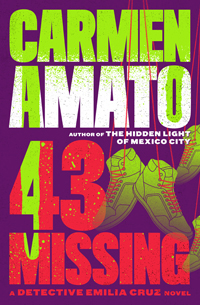
Murillo’s Arrest
So far, former attorney general Jesús Murillo Karam is the highest official thought to be involved in the crime. He was arrested at his home in Mexico City in mid-August in connection with the Sept 2014 mass disappearance in the state of Guerrero, not far from Acapulco. Murillo served as attorney general from 2012 to 2015, under then-President Enrique Peña Nieto.
Murillo was charged with torture, official misconduct and enabling forced disappearance. Along with him, charges were brought against 20 army soldiers and officers, five local officials, 33 local police officers and 11 state police, and 14 gang members. https://www.usatoday.com/story/news/world/2022/08/20/mexico-attorney-general-arrested-43-missing-students/7855468001/
As CNN reported, the arrest followed the Truth Commission’s report which labeled the students’ disappearance a “crime of the state.” The commission, which began in 2019 and is the latest in a string of investigations over the past 8 years, combed through “thousands of documents, text messages, phone records, testimonies and other forms of evidence.” https://www.cnn.com/2022/08/19/americas/jess-murillo-karam-mexico-missing-students-intl-latam/index.html
Revelations
Since Murillo’s arrest, more news has leaked out about the crime, much of which is being aired (at least in the English-language press) for the first time. The reason that facts were obscured and reporting muffled for so long appears to be a conspiracy that included local drug gangs in Guerrero, which may well have ties to larger organized crime organizations, as well as the highest levels of Mexico’s federal government during the Peña Nieto administration.
The commission report described a “deep coverup, involving multiple levels of local and federal government offices. Officials concealed facts and covered up links between the authorities and the gangs . . . At all times the federal, state and municipal authorities were aware of the students’ movements. Their actions, omissions and participation allowed for the disappearance and execution of the students.”
One shocking revelation from the commission is that six of the 43 students were kept alive for as long as four days after the initial kidnapping by police in the city of Iguala, at which point they were killed and their bodies hidden on the orders of the local army commander.
Enough, I’m Tired of This
Murillo is the one who famously said Ye me canse, meaning “Enough, I’m tired of this” in early November 2014. In a short press conference, he announced that two suspects led authorities to trash bags believed to contain the incinerated remains of the 43 missing students, then abruptly cut off reporters’ questions with the off-hand remark.
Ye me canse blew up across social media, and became a rallying call for those sick of Mexico’s narco violence and disappearances. “Enough, I’m tired of crime/narco-state/violence/government apathy.”
Meanwhile everyone else was asking Donde estan. “Where are they?”
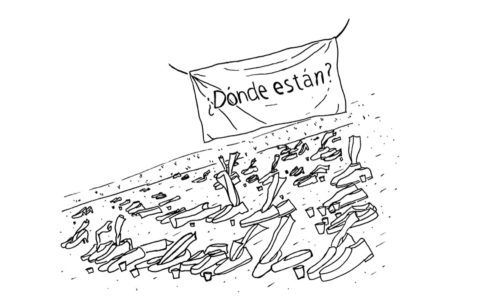
This illustration from THE ARTIST/EL ARTISTA asks “Where are they?”
“Historic Truth”
Murillo left office having created a narrative called the “Historic Truth.” This was an attempt to end the outcry with a story that the local police arrested the students then turned them over to the Guererros Unidos gang, which killed them and burned the bodies, tossing the remains into a dump.
Yet in September 2015, a group of independent experts appointed by the Inter-American Commission on Human Rights issued a 500-page report refuting the theory as scientifically impossible. https://www.amnesty.org/en/latest/news/2015/09/ayotzinapa-disappearances-pena-nieto-s-ultimate-test/
Origins of the Crime
The impetus for this sad tale of crime/coverup/collusion/conspiracy is still murky. Why did the police seize the students in the first place?
The inciting incident was when the students commandeered buses in Iguala to go to a commemorative rally in Mexico City. This isn’t necessarily a big issue in Mexico where transportation is hard to come by. The Ayotzinapa students supposedly did it every year for this event.
But this time, the students may have unwittingly commandeered a busload of drugs being transported by the Guerreros Unidos gang. And who was the gang’s partner in drug transport and distribution? Could it be the Army? Local officials? The local police? All of them?
Military angle
Mexico News Daily reported on military indictments:
“Retired Gen. José Rodríguez Pérez, a then-colonel who commanded the 27th infantry batallion at the time of the Ayotzinapa Rural Teachers College students’ disappearance in Iguala on September 26, 2014, is accused of ordering the murders of six students several days after they went missing.
“On August 19 – the day former attorney general Jesús Murillo Karam was arrested in connection with the students’ disappearance – the federal Attorney General’s Office (FGR) said that a federal judge had issued a total of 83 arrest warrants against 20 military commanders and soldiers belonging to two battalions in Iguala, five administrative and judicial officials in Guerrero, 33 municipal police officers from Huitzuco, Iguala and Cocula, 11 state police and 14 members of the criminal organization Guerreros Unidos.” https://mexiconewsdaily.com/news/arrest-warrants-ayotzinapa-general/
Unexpected Twist
After more than three years digging into the current investigation, prosecutor Omar Gómez Trejo quit this week, “raising questions about the authorities’ willingness to take on politicians and the military,” according to the Washington Post. https://www.washingtonpost.com/world/2022/09/27/mexico-ayotzinapa-missing-students-prosecutor/
Mexican Attorney General’s Office recently persuaded a judge to vacate 21 of Gómez Trejo’s 83 arrest warrants listed above. Sixteen of the 21 were for military officials.
Was the prosecutor sidelined? Is this a sign that Mexico won’t hold military officials accountable for atrocities?
Interestingly, this comes at a time when President López Obrador is relying on the military for a variety of tasks. He recently shifted put the civilian National Guard under military control. The military has taken on the civilian law enforcement role as well as chasing organized crime and running infrastructure projects.
Solving the crime in 43 MISSING
I wrote 43 MISSING, the 6th book in the Detective Emilia Cruz series, out of a huge sense of frustration with the “Historic Truth” narrative being spun at the time. There was some great counter reporting, however, notably Francisco Goldman’s content in The New Yorker. I read everything I could get my hands on and came to the conclusion that those buses were key to the mystery.
And so I wrote my version of the crime, putting Detective Emilia Cruz into an investigation not unlike the Truth Commission. In the fictional version, a new investigation brings together police officers from across Mexico to take a fresh look after previous investigation were either unequal to the task or actively prevented from investigating. Again, much like real life.
43 MISSING takes Emilia out of the familiar surroundings of Acapulco and into Mexico City. She and the team must cull through a massive amount of documentation, including video transcripts, and are given few resources for the overwhelming job.
Emilia finds those responsible for the mass disappearance . . . She finds the bodies of the dead, too.
The real Truth Commission has done the first part. Let’s hope they can do the second and without paying the price that Emilia pays in 43 MISSING.
Featured image courtesy Kindel Media via pexels
Don’t forget
Don’t forget to enter the Goodreads giveaway before 6 October for a signed copy of 43 MISSING: https://www.goodreads.com/giveaway/show/353598-43-missing-an-emilia-cruz-novel
Got a Kindle? Get 43 MISSING on Amazon here: https://geni.us/read-43-missing
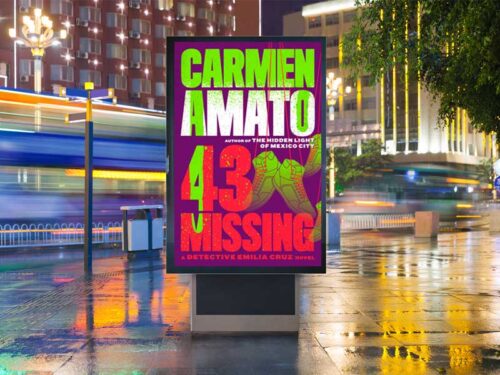
Find 43 MISSING and all the Detective Emilia Cruz books on Amazon.

Oct 4, 2021 | #EmiliaCruz, #noticed, #truestory
Chris Reed, deputy editorial and opinion editor for the San Diego Union-Tribune, recently wrote a piece entitled “Add Mexico to Afghanistan, Iraq to list of nations U.S. has severely wronged.” I was surprised to find that the article centered on the views of Don Winslow, author of THE CARTEL, etc.
Given my own opinions on the US-Mexico relationship, formed during my intelligence career and reflected in my crime fiction, you can imagine my interest.
HARD TRUTHS
Don Winslow and I both write crime fiction set in Mexico. Our books often reflect real events. But do we share similar views?
Yes, to a significant extent.
Reed’s article maintains that Winslow believes that “the 1994 North American Free Trade Agreement [NAFTA] made it so easy for cartels to move cocaine, marijuana, heroin and now fentanyl across the border into the U.S. that it has warped Mexico’s economy, undermined its democracy and gotten more than 100,000 Mexicans killed.”
The NAFTA agreement gave the US “an economic incentive to not inspect the thousands of trucks that cross the border every day with a thoroughness that would limit the cartels’ ability to earn billions of dollars by catering to American appetites for illegal drugs . . [Winslow’s] research found that DEA agents call NAFTA “the North American Free Drug Trade Agreement.”
https://www.sandiegouniontribune.com/opinion/commentary/story/2021-09-17/chris-reed-add-mexico-to-afghanistan-iraq-on-list-of-nations-u-s-has-severely-wronged
FILLING THE SIEVE
Fast forward 6 years from 1994. I was beginning to focus my intel career on the Western Hemisphere. The drug cartels were firmly entrenched and making millions every week from America’s insatiable appetite. Stories about missing persons, cartel violence, and mass graves were gruesomely common. Mexican tabloids routinely pasted horrific images across their front pages.
Gruesome and dismembered sells.
The US was spending heavily to stop the drug trade. FYI, the latest reports claim that the US has spent a trillion on the war on drugs, $34 billion in 2020 alone. https://www.cnbc.com/2021/06/17/the-us-has-spent-over-a-trillion-dollars-fighting-war-on-drugs.html
Those of us in the intelligence community did our best to fight organized crime, target cartel leaders, and staunch the flow of drugs into the US.
But we were pouring our efforts, like water, into a sieve. Lots of dirt got sifted out to be sure (Pablo Escobar, El Chapo, etc) but the rest of the US was subsidizing the drug war we were trying to stop.
The odds were not in our favor.
Related: Detective Emilia Cruz’s Origin Story
FOLLOW THE MONEY
In his article, Reed quotes Winslow’s 2015 open letter to the White House:
“It’s not the ‘Mexican drug problem.’ It’s the American drug problem. . . It’s simple: no buyer, no seller. We fund the killing, fuel the killing, and sustain the killing (my emphasis) . . . You’re so concerned about terrorists thousands of miles away that you don’t see the terrorists just across our border. The cartels are more sophisticated and wealthier than the jihadists and already have a presence in 230 American cities. The cartels were running the ISIS playbook — decapitations, immolations, videos, social media — 10 years ago.”
In short, organized crime/cartels are armed, cunning, and ruthless, and we are paying them top dollar.
The year after Winslow penned that letter, US drug users spent $150 billion on cocaine, heroin, marijuana, and methamphetamine, according to the Rand Corporation. https://www.rand.org/pubs/research_reports/RR3140.html
Let’s get some perspective. $150 billion is more than 7% of the US GDP. According to largest.org, which calculated the largest industry sectors in the US, $150 billion per year is more than each of the following economic sectors: durable goods manufacturing, finance and insurance, and state and local government spending. https://largest.org/technology/industries/
That was in 2016. What are we spending now?
More recently, Addiction Centers posted an astounding graphic, claiming users in the US spend $56 million per day on meth and almost $47 million per day on cocaine. I didn’t see their methodology but neither do I have information to say those numbers aren’t for real. https://addiction-treatment.com/in-depth/what-america-spends-on-drug-addictions
BY THE NUMBERS
The National Center for Drug Abuse Statistics and the Centers for Disease Control keep rolling out statistics that should be front page news, but sadly are not.
Let’s start with cocaine. According to the CDC about cocaine-related deaths in the US:
- 90,000 deaths by overdose in 2019.
- 93,000 deaths by overdose in 2020.
Now some joy about fentanyl. FYI, it’s called the “Drug of Mass Destruction.”
- 42,687 overdose deaths (OD) involved fentanyl in the 12 months leading up to May 2020.
- Fentanyl OD rates are rising 2.5 times faster than heroin ODs.
- Fentanyl ODs outpace prescription opioid ODs 550.94%.
- 2.2 lbs (1 kilogram) of fentanyl contains 250,000 lethal doses.
According to the Washington Free Beacon, “Fentanyl seizures in 2021 have nearly doubled 2020 numbers, according to records quietly released by Customs and Border Protection. The “Drug Seizure Statistics” tool run by the agency disclosed [earlier in September] that agents already seized 9,337 pounds of fentanyl by the end of July, a 94 percent increase from the 4,791 pounds seized in the entirety of 2020 . . . Experts say that just two milligrams of fentanyl can cause a lethal overdose to people with no tolerance for the drug, meaning the amount of the drug seized by CBP through July could potentially kill two billion people.” https://freebeacon.com/biden-administration/fentanyl-smuggling-surges-at-border/
NYPD data from April 2021 shows that one out of every 10 bags of cocaine sold on the street in NY contains fentanyl.
- 80% of the heroin tested by the NYPD contains fentanyl.
- 2/3 of OD deaths in NYC involved fentanyl.
I recently saw articles about the party scene in New York City coming back, warning friends to stay hydrated and carry Narcan because the cocaine supply is laced with fentanyl. https://gothamist.com/news/if-youre-partying-again-in-nyc-be-wary-of-fentanyl-laced-cocaine
No articles telling friends not to take cocaine.
WHAT THIS BUYS FOR MEXICO
In RUSSIAN MOJITO, I wrote: “Money flowed through each operation, and in Mexico, money and drugs always swam in the same river.”
The money that the US pays to consume illicit drug washes through every sector of Mexican society. Drug money is a way to sidestep Mexico’s rigid social system, lack of rural infrastructure, and weak civil leadership.
Fueled by the US appetite for drugs, organized crime is leaching away civil authority. Politicians are easily bought and even if they weren’t, the organs of civil order are too small, too poorly paid, and too poorly vetted to stand against the bulldozer of organized crime.
Organized crime factions vie for control of the industry even as they branch out into extortion, kidnappings, fuel theft, etc. The result is more violence, more pressure on civil authority, more money to line pockets.
For example, look at the 6 June 2021 elections in Mexico. Think of it as Mexico’s mid-terms. 500 seats in the lower house of the federal Congress, 15 state governorships and thousands of local leadership positions were up for grabs.
It was a massively violent election season. Reuters reported that 97 politicians were killed and almost 1000 were attacked, most at the local level.
In Tijuana someone threw a severed human head at a voting station on election day. Plastic bags filled with body parts were found nearby.
If you read the news from the region with any regularity, bodies in trash bags are mentioned far too often.
THE BRUTAL BENCHMARK
In the Detective Emilia Cruz series, she keeps a binder of reports of missing women that she calls Las Perdidas. Emilia’s hunt for them is a running theme throughout the series and the plot of the 2019 Silver Falchion award winning story, The Artist.
Why write about missing persons? Because the numbers of missing and disappeared persons has become the benchmark of how bad things are in Mexico.
The number of missing in Mexico continues to rise. No one really has a hard number but something like 90,000 people have gone missing in the past 15 years.
That’s a quarter of St. Paul, Minnesota. It’s the entirety of Murfreesboro, Tennessee down the road from me.
It’s the number of overdose deaths in the US in 2019.
Mexico is littered with mass gravesites full of unidentified bodies but lacks good recordkeeping so it’s hard to know just how many bodies have been discovered. Nor is there a link between finding bodies and a database of the missing. Ergo, identification lags far behind discovery. http://www.borderlandbeat.com/2021/09/platform-on-mass-graves-is-born-in.html
When they were looking for the remains of the 43 students who were victims of a mass kidnapping back in September 2014, the tragedy I wrote about in 43 MISSING, they found scores of unidentified bodies in graves in the state of Guerrero, not so far from the resort city of Acapulco.
But those weren’t the bodies they were looking for.
THE BIG QUESTION
Chris Reed and Don Winslow remind us that US drug use paid for all those graves.
Why aren’t more people talking about this?
Some links to check out:
National Security this Week with guest Carmen Amato: https://kymnradio.net/2021/08/04/national-security-this-week-with-carmen-amato-8-4-21-intelligence-operations/
The Ascent of Narco Noir: A Literary Game Changer: https://www.criminalelement.com/ascent-narco-noir/
CLIFF DIVER: Detective Emilia Cruz Book 1: https://geni.us/cliff-diver




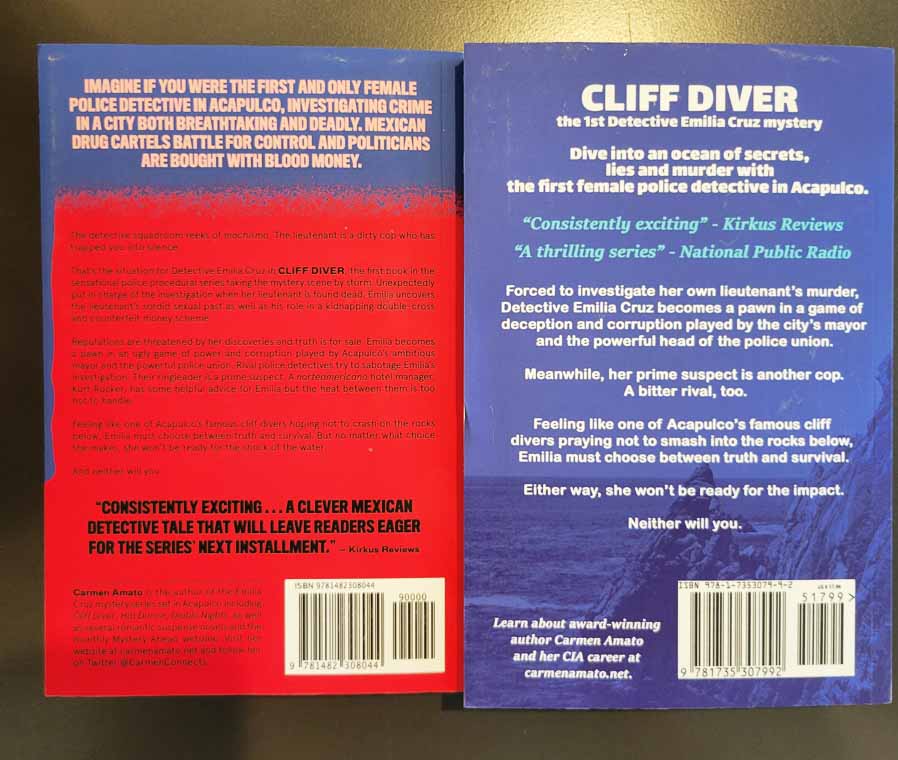
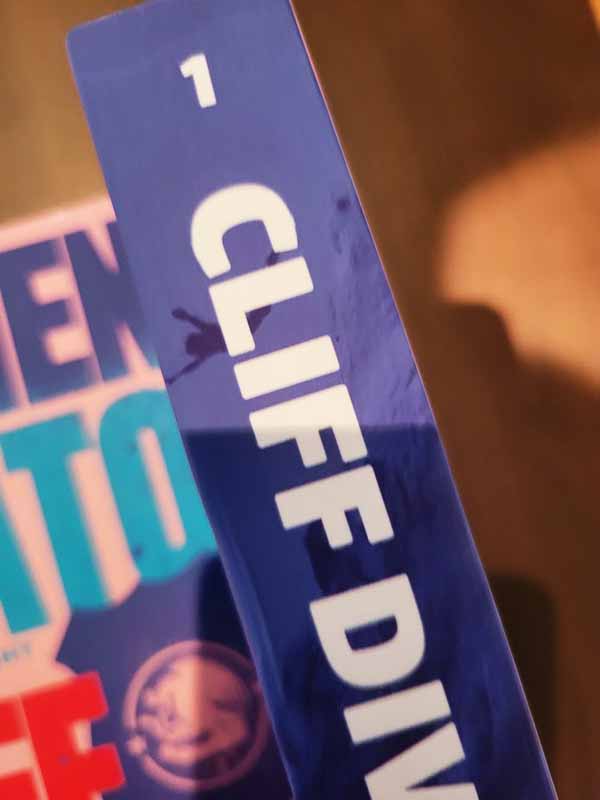





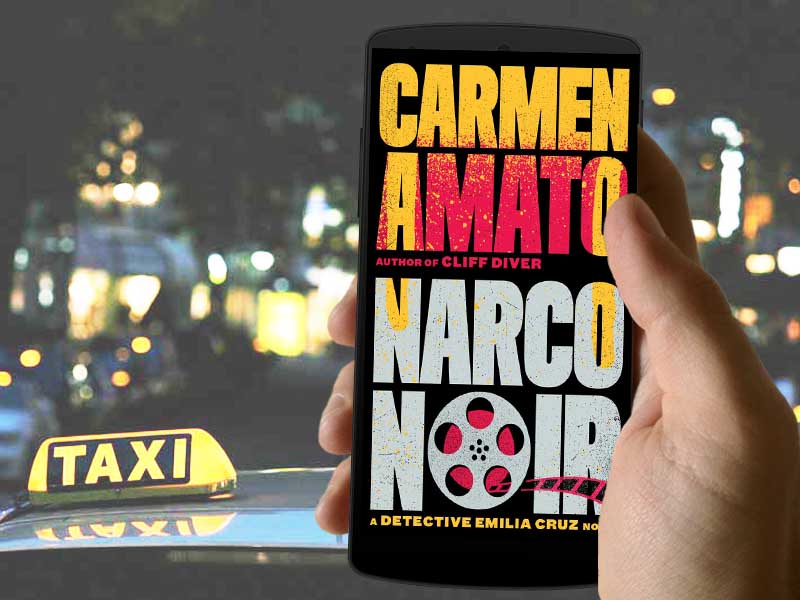

 We were two, my cousin and I, sitting comfortably at the back of a taxi in Singapore, heading to Shenton Way, the business district. With a mild traffic and fair weather, we chatted away as the Chinese driver took us to our destination.
We were two, my cousin and I, sitting comfortably at the back of a taxi in Singapore, heading to Shenton Way, the business district. With a mild traffic and fair weather, we chatted away as the Chinese driver took us to our destination. Early in my scientific career I flew to Amsterdam in The Netherlands to present a paper at a major scientific meeting. This was going to be my first ever visit to Holland.
Early in my scientific career I flew to Amsterdam in The Netherlands to present a paper at a major scientific meeting. This was going to be my first ever visit to Holland. 1995, Naples, Italy
1995, Naples, Italy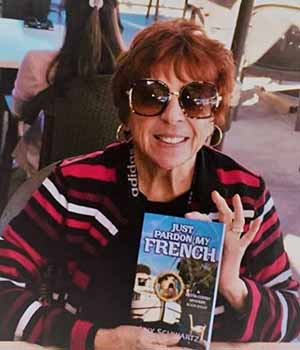 So, I got to a booksigning/bookfest in central Texas (the name of the town and fest shall remain untold in order to protect the guilty).
So, I got to a booksigning/bookfest in central Texas (the name of the town and fest shall remain untold in order to protect the guilty).








